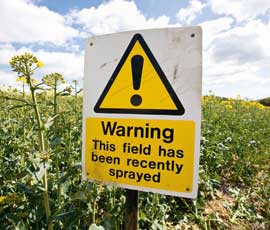Four new fungicides to tackle oilseed rape disease

A new range of SDHI fungicides specifically targeting oilseed rape diseases will be available to growers this year, with sclerotinia control one of the major benefits.
Tony John, technical director at adviser Procam, believes they will be a worthwhile investment in such a lucrative crop, which has suffered from recent harsh weather conditions.
A mix of two actives from Bayer (fluopyram + prothioconazole) will be distributed as Propulse by Procam and as Recital by fellow adviser Agrovista. The fluopyram element is a special SDHI to target oilseed rape diseases.
Mr John’s advice to growers is to use Propulse at mid- to late flowering within a two-spray approach this year to combat the risk of sclerotinia.
“All the fungicides we have are only protectants that will last three weeks, so what we are advocating is two flowering sprays – one at yellow bud early flowering and then the Propulse at mid- to late flowering,” he says.
“The product is particularly active on sclerotinia as well as the late season disease alternaria,” Mr John adds.
Growers are being advised that as sclerotinia fungicides are only protectants, they need to be sprayed before the infection has occurred on the petals.
Mr John suggests an application of 0.8l/ha and believes it will offer some of the best control in relation to similarly priced products.
“It’s very effective on sclerotinia and also offers between 72-100% alternaria control, which is much more effective than straight prothioconazole.
“We have products that don’t have alternaria control, so we will put those on early in the season. We’ll look at using something like picoxystrobin, because it will have an effect on verticillium wilt as well,” he says.
| Actives |
|---|
|
Recital contains the same actives as Propulse, including fluopyram. Mark Hemmant, technical manager at Agrovista, says its excellent control on sclerotinia is accompanied by control of downy mildew and other diseases.
Mr Hemmant says growers should be wary of a one-spray programme this year, but Recital will provide an excellent accompaniment in a two-spray programme.
“The problem with rape is that flowering lasts more than three weeks, but none of the sclerotinia products give you more than three weeks protection, so one spray is always a gamble,” he says.
Mr Hemmant believes growers going for two sprays should aim for a yellow bud spray such as Galileo (picoxystrobin), which gives some strong yield increase and a greening effect that covers you till the mid-flowering timing, as well as having an effect on sclerotinia.
“Then you go on with the specialist, which will take you through the next few weeks. Usually two sprays takes you all the way through flowering, but we’ll just have to wait and see this year,” he says.
Two further products will also be available to growers this season using actives from Bayer, and will also offer more plant growth regulator activity through using tebuconazole.
Skyway and Sparticus use the same actives (bixafen + prothioconazole and tebuconazole), with the former available through Frontier and the latter from Hutchinson’s.
Both mixes have been transferred from use in cereals, but have performed well in oilseed rape trials.
Bob Mills, technical manager at Frontier, suggests Skyway will probably be the first fungicide growers will put on, as it performs well at mid-flowering for sclerotinia.
Both products will have an effect on light leaf spot, which experts believe could be prevalent this year.
“Rates will depend on whether it’s a two-spray or one-spray programme. If it’s a one-spray programme I’d go with 1 litre/ha, and if it’s in a combination with other chemistry I’d probably put on 0.75 litre/ha,” says Mr Mills.
Peter Gladders, plant pathologist at ADAS, feels both Propulse and Recital will rival Proline (prothioconazole) and Prosaro (prothioconazole + tebuconazole), but admits Proline in particular is a tough product to match in terms of its efficacy.
“Skyway has possibly got a bit more growth regulation than Propulse because of the tebuconazole. You are fine-tuning according to your own farm, but at the end of the day I think one of the main deciding factors will be money,” says Dr Gladders.
There are going to be thinner crops this season, so these probably will not need the growth regulator input than a bigger crop is likely to need.
Mixtures of actives help prevent the build-up of fungicide resistance and growers are urged not to use single actives more than once on their own.
Growers are being reminded to look out for sclerotinia in spring oilseed rape as well.
“It may be the only fungicide you use on spring rape is a sclerotinia spray at early to mid-flowering, but these new mixes with prothioconazole and tebuconazole will also keep powdery mildew out,” Dr Gladders adds.
Read more articles on fungicides
Disease control is a priority with grain prices high
Early fungicide spray can keep barley diseases at bay
Higher spend pays off in tough disease year
Triazole troubles will bring disease control headaches

